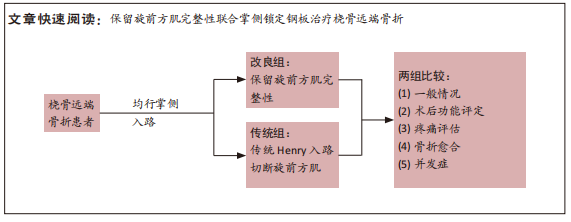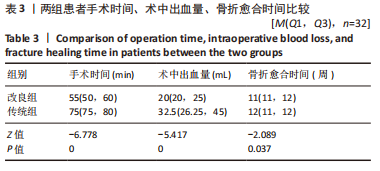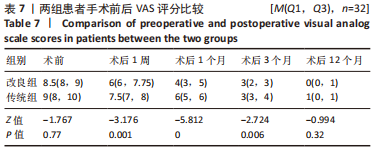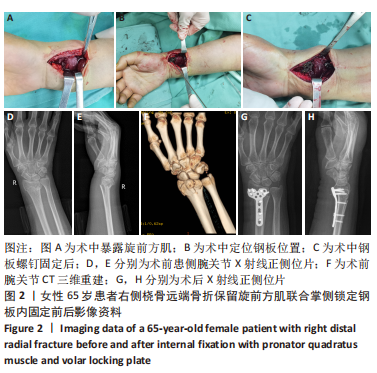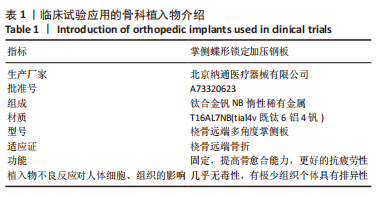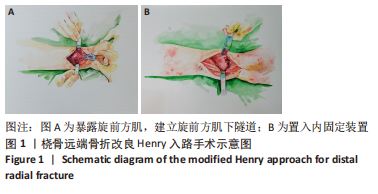[1] 黄晓夏,伊尔夏提·克力木,彭聪,等. 改良Henry入路治疗桡骨远端AOB型骨折的疗效分析[J]. 中华骨与关节外科杂志,2022,15(1): 43-48.
[2] CHUNG KC, SPILSON SV. The frequency and epidemiology of hand and forearm fractures in the United States. J Hand Surg Am. 2001;26(5): 908-915.
[3] SMITH DW, HENRY MH. Volar fixed-angle plating of the distal radius. J Am Acad Orthop Surg. 2005;13(1):28-36.
[4] QUADLBAUER S, PEZZEI C, JURKOWITSCH J, et al. Early complications and radiological outcome after distal radius fractures stabilized by volar angular stable locking plate. Arch Orthop Trauma Surg. 2018;138(12): 1773-1782.
[5] PLANT CE, PARSONS NR, COSTA ML. Do radiological and functional outcomes correlate for fractures of the distal radius?Bone Joint J. 2017;99(3):376-382.
[6] JOHNSON RK, SHREWSBURY MM. The pronator quadratus in motions and in stabilization of the radius and ulna at the distal radioulnar joint. J Hand Surg Am. 1976;1(3):205-209.
[7] ARMANGIL M, BEZIRGAN U, BAŞARıR K, et al. The pronator quadratus muscle after plating of distal radius fractures: is the muscle still working? Eur J Orthop Surg Traumatol. 2014;24(3):335-339.
[8] 钱忠卫,张巧云. 旋前方肌对前臂旋前功能的影响[J]. 中华手外科杂志,2021,37(4):255-257.
[9] CHLOROS GD, PAPADONIKOLAKIS A, GINN S, et al. Pronator quadratus space and compartment syndrome after low-energy fracture of the distal radius: a case report. J Surg Orthop Adv. 2008 Summer;17(2):102-106.
[10] BERGLUND LM, MESSER TM. Complications of volar plate fixation for managing distal radius fractures. J Am Acad Orthop Surg. 2009;17(6): 369-377.
[11] HERSHMAN SH, IMMERMAN I, BECHTEL C, et al. The effects of pronator quadratus repair on outcomes after volar plating of distal radius fractures. J Orthop Trauma. 2013;27(3):130-133.
[12] MULDERS MAM, WALENKAMP MMJ, BOS FJME, et al. Repair of the pronator quadratus after volar plate fixation in distal radius fractures: a systematic review. Strategies Trauma Limb Reconstr. 2017;12(3):181-188.
[13] KIM JK, PARK JS, SHIN SJ,et al. The effect of brachioradialis release during distal radius fracture fixation on elbow flexion strength and wrist function. J Hand Surg Am. 2014;39(11):2246-2250.
[14] GOORENS CK, DE KEYZER PB, VAN ROYEN K,et al. Pronator quadratus repair after volar plate fixation in distal radial fractures: evaluation of the clinical and functional outcome and of the protective role on the flexor tendons-a randomized controlled study. Eur J Orthop Surg Traumatol. 2021;31(3):541-548.
[15] FEENEY MS, WENTORF F, PUTNAM MD. Simulation of altered excursion of the pronator quadratus. J Wrist Surg. 2014;3(3):198-202.
[16] NHO JH, GONG HS, SONG CH, et al. Examination of the pronator quadratus muscle during hardware removal procedures after volar plating for distal radius fractures. Clin Orthop Surg. 2014;6(3):267-272.
[17] SHI F, REN L. Is pronator quadratus repair necessary to improve outcomes after volar plate fixation of distal radius fractures? A systematic review and meta-analysis. Orthop Traumatol Surg Res. 2020; 106(8):1627-1635.
[18] LU CK, LIU WC, CHANG CC,et al. A systematic review and meta-analysis of the pronator quadratus repair following volar plating of distal radius fractures. J Orthop Surg Res. 2020;15(1):419.
[19] BERTELLI JA, GHIZONI MF. Reconstruction of C5 and C6 brachial plexus avulsion injury by multiple nerve transfers: spinal accessory to suprascapular, ulnar fascicles to biceps branch, and triceps long or lateral head branch to axillary nerve. J Hand Surg Am. 2004;29(1):131-139.
[20] SWIGART CR, BADON MA, BRUEGEL VL, et al. Assessment of pronator quadratus repair integrity following volar plate fixation for distal radius fractures: a prospective clinical cohort study. J Hand Surg Am. 2012;37(9):1868-1873.
[21] HOHENDORFF B, UNGLAUB F, SPIES CK, et al. Refixierung des Musculus pronator quadratus mit einem Teil des M.-brachioradialis-Ansatzes bei der palmaren Plattenosteosynthese einer distalen Radiusfraktur [Repair of the pronator quadratus muscle with a part of the brachioradialis muscle insertion in volar plate fixation of a distal radius fracture]. Oper Orthop Traumatol. 2020;32(1):82-86.
[22] KASHIR A, O’DONNELL T. A Brachioradialis Splitting Approach Sparing the Pronator Quadratus for Volar Plating of the Distal Radius. Tech Hand Up Extrem Surg. 2015;19(4):176-181.
[23] HEIDARI N, CLEMENT H, KOSUGE D,et al. Is sparing the pronator quadratus muscle possible in volar plating of the distal radius? J Hand Surg Eur Vol. 2012;37(5):402-406.
[24] LIVERNEAUX PA. The minimally invasive approach for distal radius fractures and malunions. J Hand Surg Eur Vol. 2018;43(2):121-130.
[25] REY PB, ROCHET S, LOISEL F, et al. Technical note: How to spare the pronator quadratus during MIPO of distal radius fractures by using a mini-volar plate. Chir Main. 2014;33(2):95-99.
[26] SALGARELLO M, VISCONTI G, BARONE-ADESI L. Interlocking circumareolar suture with undyed polyamide thread: a personal experience. Aesthetic Plast Surg. 2013;37(5):1061-1062.
[27] 王楠,杜国庆,蔡雨卫,等.桡骨远端骨折固定方法的研究进展[J].医学综述,2020,26(6):1131-1136.
[28] 李彦宇,赵岩,李孟杰.改良Henry入路治疗不稳定桡骨远端骨折疗效分析[J].中国骨与关节杂志,2020,9(9):654-660.
[29] MIRARCHI AJ, NAZIR OF. Minimally Invasive Surgery: Is There a Role in Distal Radius Fracture Management? Curr Rev Musculoskelet Med. 2021;14(1):95-100.
[30] HUANG HK, WANG JP, CHANG MC. Repair of Pronator Quadratus With Partial Muscle Split and Distal Transfer for Volar Plating of Distal Radius Fractures. J Hand Surg Am. 2017;42(11):935.e1-935.e5.
[31] ARORA R, LUTZ M, HENNERBICHLER A, et al. Complications following internal fixation of unstable distal radius fracture with a palmar locking-plate. J Orthop Trauma. 2007;21(5):316-322.
[32] DUNCAN SF, WEILAND AJ. Delayed rupture of the flexor pollicis longus tendon after routine volar placement of a T-plate on the distal radius. Am J Orthop (Belle Mead NJ). 2007;36(12):669-670.
[33] Rampoldi M, Marsico S. Complications of volar plating of distal radius fractures. Acta Orthop Belg. 2007;73(6):714-719.
[34] GRADL G, MIELSCH N, WENDT M, et al. Intramedullary nail versus volar plate fixation of extra-articular distal radius fractures. Two year results of a prospective randomized trial. Injury. 2014;45 Suppl 1:S3-8.
[35] PIERRART J, TORDJMAN D, IKEUCHI N,et al. Lésions nerveuses associées aux fractures de l’extrémité distale du radius [Nerve injuries associated with distal radius fractures]. Hand Surg Rehabil. 2016;35S:S75-S79.
[36] LIVERNEAUX P, ICHIHARA S, FACCA S,et al. Résultats de l’ostéosynthèse par plaque antérieure et abord mini-invasif (MIPO) des fractures de l’extrémité distale du radius : mise au point [Outcomes of minimally invasive plate osteosynthesis (MIPO) with volar locking plates in distal radius fractures: A review]. Hand Surg Rehabil. 2016;35S:S80-S85.
[37] SONNTAG J, HERN J, WOYTHAL L, et al. The Pronator Quadratus Muscle After Volar Plating: Ultrasound Evaluation of Anatomical Changes Correlated to Patient-Reported Clinical Outcome. Hand (N Y). 2021;16(1):32-37.
[38] FANG K, LIN X, LIU X, et al. Do we need to suture the pronator quadratus muscle when we do open reduction and internal fixation for fracture of the distal radius. BMC Musculoskelet Disord. 2020; 21(1):453.
[39] 闵捷, 郭雅娣, 廖晓辉,等. 保留旋前方肌桡骨远端骨折内固定术的解剖学及临床研究[J]. 中华创伤骨科杂志,2018,20(5):376-381.
[40] OBERT L, LOISEL F, GASSE N, et al. Distal radius anatomy applied to the treatment of wrist fractures by plate: a review of recent literature. SICOT J. 2015;1:14.
[41] AGNEW SP, LJUNGQUIST KL, HUANG JI. Danger zones for flexor tendons in volar plating of distal radius fractures. J Hand Surg Am. 2015;40(6): 1102-1105.
[42] 朱宗东,廖锋,魏丹,等.充填植骨并部分保留旋前方肌掌侧锁定钢板内固定治疗桡骨远端C3.1、C3.2型骨折[J].中华手外科杂志, 2022,38(3):214-217.
[43] HUANG X, JIA Q, LI H, et al. Evaluation of sparing the pronator quadratus for volar plating of distal radius fractures: a retrospective clinical study. BMC Musculoskelet Disord. 2022;23(1):625.
[44] 彭聪,黄晓夏,孔维奇,等. 两种术中透视方法在桡骨远端骨折掌侧接骨板固定时的应用价值对比[J]. 中华骨与关节外科杂志,2022, 15(5):341-347. |
